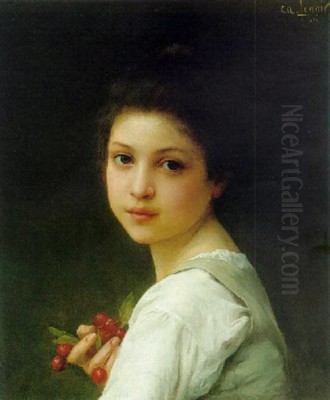
Charles Amable Lenoir stands as a distinguished figure in the annals of French art, a painter whose career flourished during the vibrant and transformative period of the late nineteenth and early twentieth centuries. Born on October 22, 1860, in Châtelaillon, a small village near La Rochelle in the Charente-Maritime region of France, and passing away on August 1, 1926, in Fouras, Lenoir dedicated his life to the pursuit of artistic excellence within the esteemed tradition of French Academic painting. His oeuvre is celebrated for its refined realism, its delicate portrayal of the human form, particularly female subjects, and its masterful handling of light and color. Lenoir was a student of the renowned William-Adolphe Bouguereau, and his work reflects the high standards of craftsmanship and aesthetic beauty championed by the Académie des Beaux-Arts. Throughout his career, he garnered significant accolades, including the prestigious Prix de Rome on two occasions and the Legion of Honour, testaments to his skill and the esteem in which he was held by his contemporaries.
Early Life and Formative Influences
Charles Amable Lenoir's journey into the world of art was not immediate but rather a path discovered after initial forays into other professions. His father was a customs officer, and his mother worked as a seamstress. Due to his father's occupation, the Lenoir family experienced several relocations during Charles's youth, eventually settling in Fouras. This coastal town, with its picturesque landscapes and tranquil atmosphere, would remain a significant place for Lenoir throughout his life, a sanctuary to which he would return each summer.
His early education took place at a teacher's college in La Rochelle. Following his studies, Lenoir embarked on a career as a teacher and supervisor. However, the allure of art and the burgeoning desire to create proved too strong to ignore. The artistic currents of Paris, the epicenter of the art world at the time, beckoned. In 1883, a pivotal year, Lenoir made the decision to pursue his artistic aspirations more formally and enrolled at the prestigious École des Beaux-Arts in Paris. This institution was the bastion of Academic art, upholding classical ideals and rigorous training methods.
Academic Training under Bouguereau
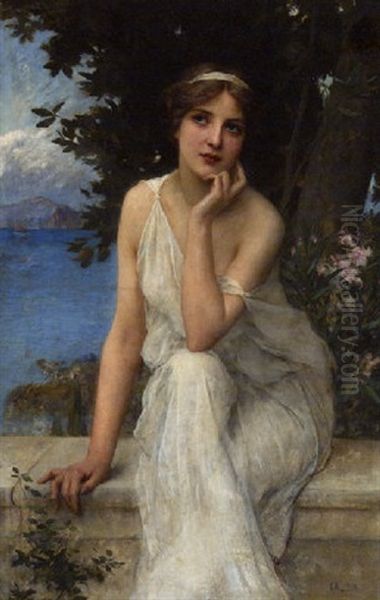
At the École des Beaux-Arts, Lenoir had the distinct privilege of studying under William-Adolphe Bouguereau, one of the most celebrated and influential Academic painters of the era. Bouguereau was known for his exquisitely finished paintings, often depicting mythological or idyllic pastoral scenes, and for his masterful rendering of the human form. His tutelage would have a profound and lasting impact on Lenoir's artistic development.
The training at the École was rigorous, emphasizing draftsmanship, the study of anatomy, and the copying of Old Masters. Students progressed through a structured curriculum designed to instill a deep understanding of classical principles and technical proficiency. Bouguereau, as a professor, was known for his dedication to his students and his insistence on precision and beauty. Under his guidance, Lenoir honed his skills, absorbing the tenets of Academic painting: clarity of form, smooth brushwork, idealized subjects, and harmonious compositions. This period was crucial in shaping Lenoir's signature style, characterized by its elegance, sensitivity, and meticulous attention to detail. He also studied alongside Tony Robert-Fleury, another prominent Academic painter and influential teacher at the Académie Julian, further immersing himself in the established artistic traditions of the time.
Artistic Style and Thematic Focus
Charles Amable Lenoir's artistic style is firmly rooted in the French Academic tradition, yet it possesses a distinct charm and sensitivity that is uniquely his own. He was a master of realism, imbuing his subjects with a lifelike quality while often idealizing them to achieve a sense of timeless beauty. His palette was typically warm and rich, contributing to the inviting and often serene atmosphere of his paintings.
A significant portion of Lenoir's oeuvre is dedicated to the portrayal of women. He excelled at capturing the grace, innocence, and allure of his female subjects, whether they were depicted as young girls, pensive shepherdesses, diligent seamstresses, or figures from mythology. His paintings often feature solitary female figures, allowing for an intimate exploration of their character and mood. Works such as The Seamstress (La Couturière) and Meditation showcase his ability to convey quiet introspection and gentle beauty.
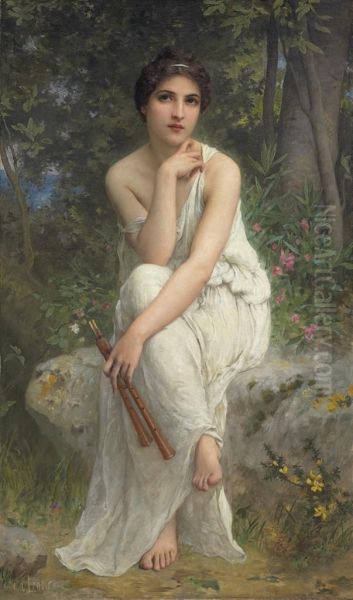
Mythological themes also feature prominently in his work. Lenoir painted nymphs, sirens, and goddesses like Venus, often set in idyllic, dreamlike landscapes. These paintings demonstrate his classical training and his ability to render complex compositions with a polished finish. His attention to detail was remarkable, evident in the soft texture of hair, the delicate rendering of fabric, the subtle play of light on skin, and even the ephemeral quality of elements like bubbles in some of his more whimsical pieces. The clear outlines and carefully modeled forms in his paintings are hallmarks of the Academic style he so expertly practiced.
Major Works and Esteemed Recognition
Throughout his career, Charles Amable Lenoir produced a body of work that garnered considerable acclaim and numerous accolades. His dedication to the principles of Academic art, combined with his innate talent, led to success in the highly competitive Parisian art world.
His talent was recognized early on with the prestigious Prix de Rome, an award granted by the French government that allowed promising young artists to study in Rome. Lenoir was a recipient of this coveted prize on two occasions, a rare and significant achievement. His submissions for the prize, likely including works such as Jésus et le paralytique (Jesus and the Paralytic) and Le Reniement de Saint Pierre (The Denial of St. Peter), demonstrated his mastery of historical and religious subjects, which were highly valued by the Academy.
Lenoir was a regular exhibitor at the Paris Salon, the official art exhibition of the Académie des Beaux-Arts and the most important art event in the Western world at the time. His paintings were consistently well-received, earning him medals and further establishing his reputation. In 1889 and 1890, he won the second Prix de Rome, and in 1900, he was awarded a bronze medal at the Exposition Universelle (World's Fair) in Paris. His contributions to French art were further recognized when he was made a Chevalier de la Légion d'Honneur (Knight of the Legion of Honour) in 1903, one of France's highest civilian decorations.
Among his many celebrated paintings, several stand out as representative of his style and thematic concerns. Meditation, The Flute Player, and The Seamstress are often cited as key examples of his genre scenes featuring graceful women. A Young Woman Playing the Aulos and The Pink Rose further exemplify his skill in capturing feminine charm and elegance. His mythological painting, Pandora, has also gained significant attention, particularly in recent times.
The Academic Tradition in a Changing Art World
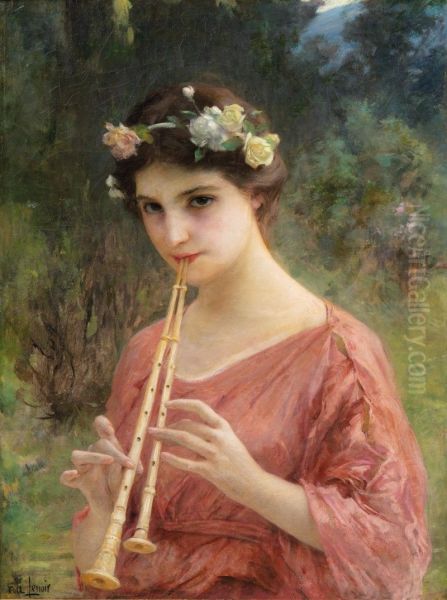
Charles Amable Lenoir practiced his art during a period of profound artistic change. The Academic tradition, with its emphasis on classical ideals, historical subjects, and polished technique, had dominated European art for centuries. Institutions like the École des Beaux-Arts and the Paris Salon were the gatekeepers of artistic taste and success. Artists like William-Adolphe Bouguereau, Jean-Léon Gérôme, Alexandre Cabanel, and Ernest Meissonier were titans of this establishment, producing works of incredible technical skill and often grand narrative scope. Léon Bonnat was another highly respected Academic painter, particularly known for his portraiture. Tony Robert-Fleury, Lenoir's other teacher, also played a significant role in upholding these traditions.
However, the late nineteenth century also witnessed the rise of revolutionary art movements that challenged the hegemony of Academic art. Realism, championed by artists like Gustave Courbet, sought to depict the world and its people without idealization, focusing on everyday life and social issues. This movement paved the way for Impressionism, which emerged in the 1860s and 1870s.
Impressionists such as Claude Monet, Pierre-Auguste Renoir, Edgar Degas, Camille Pissarro, Alfred Sisley, and Berthe Morisot broke radically with Academic conventions. They favored painting en plein air (outdoors), capturing fleeting moments and the transient effects of light and color. Their brushwork was often loose and visible, their subjects drawn from modern life, and their compositions less formal. Édouard Manet, though often associated with the Impressionists and a key figure in the transition to modern art, maintained a complex relationship with the Salon, seeking its acceptance while simultaneously subverting its norms.
The rise of Impressionism and subsequent movements like Post-Impressionism (with figures such as Paul Cézanne, Vincent van Gogh, and Georges Seurat) and Neo-Impressionism gradually shifted the focus of the avant-garde away from Academic art. Despite these seismic shifts, Academic painters like Lenoir continued to work and find patronage, and the Salon remained a powerful institution for many years. Lenoir's adherence to the Academic style, under the direct influence of Bouguereau, placed him firmly within the established tradition, even as new artistic languages were being forged around him. There is no specific record of direct artistic collaborations between Lenoir and the leading Impressionists, as their artistic philosophies and circles, while contemporaneous, were largely distinct. His primary interactions would have been within the Academic sphere, centered around the École and the Salon.
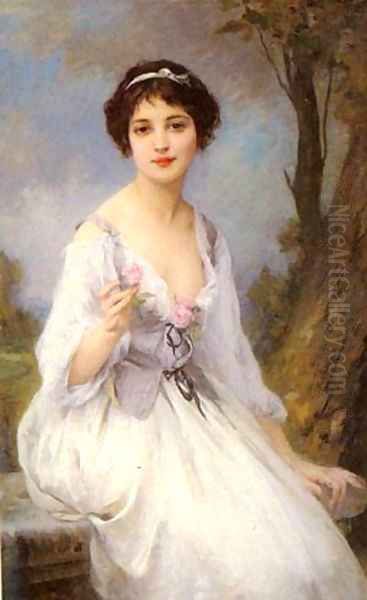
The context of these competing artistic visions is essential for understanding Lenoir's career. He was a product of, and a contributor to, a tradition that valued technical mastery, beauty, and narrative clarity. While the avant-garde movements would eventually come to dominate historical narratives of the period, Academic art represented the mainstream and officially sanctioned art of its time, enjoyed by a vast public and supported by state institutions. Artists like Jules Bastien-Lepage occupied an interesting space, with a style that blended Academic finish with Naturalist subject matter, sometimes seen as a bridge or alternative to both strict Academicism and Impressionism.
Later Years, Personal Life, and Enduring Connection to Fouras
Throughout his successful career in Paris, Charles Amable Lenoir maintained a deep connection to Fouras, the coastal town where his family had settled during his youth. Each summer, he would retreat from the bustling art scene of the capital to this quieter, more familiar environment. These sojourns likely provided him with inspiration and a respite from the demands of his professional life.
Lenoir remained unmarried throughout his life. While details about his personal life are not extensively documented, his dedication to his art appears to have been paramount. His summers in Fouras were a constant, a return to his roots and perhaps a source of creative rejuvenation. The landscapes and the people of the Charente-Maritime region may have subtly influenced his work, even if his primary subjects were often idealized or mythological.
He continued to paint and exhibit his work until his death on August 1, 1926, in Fouras. His passing marked the end of a distinguished career dedicated to the pursuit of beauty and technical excellence within the Academic tradition. In recognition of his artistic contributions and his connection to the town, a monument was later erected in Fouras in his memory, a lasting tribute from the community that he considered home.
Legacy and Modern Re-evaluation
For much of the twentieth century, as Modernism became the dominant narrative in art history, Academic painters like Charles Amable Lenoir, and even his celebrated mentor Bouguereau, fell into relative obscurity. The emphasis shifted towards the avant-garde movements that had challenged the Academy, and the polished, idealized works of the Academic tradition were often dismissed as sentimental or outmoded. Art historical discourse tended to champion innovation and rupture over tradition and refinement.
However, in recent decades, there has been a significant re-evaluation of nineteenth-century Academic art. Scholars and collectors have begun to look anew at these artists, appreciating their extraordinary technical skill, their dedication to craftsmanship, and the undeniable beauty of their creations. The narrative of art history has become more inclusive, recognizing the value and importance of various artistic expressions that coexisted during this dynamic period.
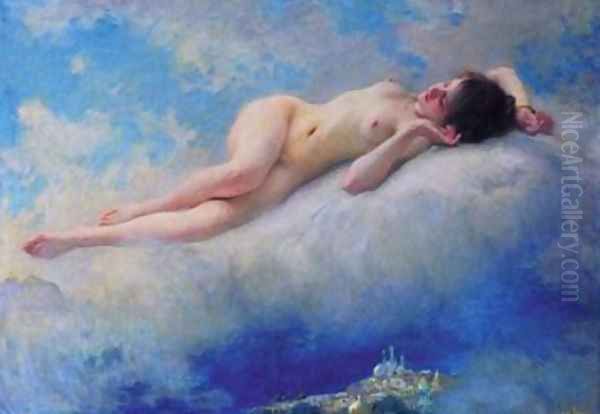
Charles Amable Lenoir's work has benefited from this renewed interest. His paintings, with their elegant figures, harmonious compositions, and exquisite finish, are increasingly sought after by collectors. Auction prices for his works have risen, indicating a growing appreciation in the art market. For instance, his painting Pandora achieved a new world auction record for the artist in 2023, a clear sign of his posthumous resurgence.
His legacy lies in his contribution to the French Academic tradition, particularly his sensitive and graceful portrayals of women and his mastery of mythological subjects. He stands as an exemplar of the high standards of the École des Beaux-Arts and the Paris Salon system. While he may not have been an avant-garde revolutionary, his work represents a significant stream of artistic production in the late nineteenth and early twentieth centuries, one that valued beauty, skill, and the continuation of classical ideals. His paintings offer a window into the aesthetic sensibilities of his time and continue to enchant viewers with their timeless elegance and refined artistry.
Conclusion: An Enduring Elegance
Charles Amable Lenoir was a quintessential French Academic painter, a skilled artist who dedicated his life to creating works of enduring beauty and technical brilliance. Nurtured under the guidance of William-Adolphe Bouguereau and steeped in the traditions of the École des Beaux-Arts, he forged a successful career, earning prestigious awards and the admiration of his contemporaries. His paintings, characterized by their graceful figures, warm palettes, and meticulous detail, celebrate an idealized vision of femininity and draw inspiration from the rich well of mythology and genre scenes.
While the tides of artistic taste shifted dramatically during and after his lifetime, leading to a period where Academic art was often overlooked, recent years have seen a renewed appreciation for Lenoir's contributions. His work stands as a testament to the enduring appeal of skilled craftsmanship and classical beauty. As an art historian, one recognizes Charles Amable Lenoir not only as a product of his time but also as an artist whose dedication to his craft resulted in a body of work that continues to captivate and inspire, securing his place within the rich tapestry of nineteenth-century French art.